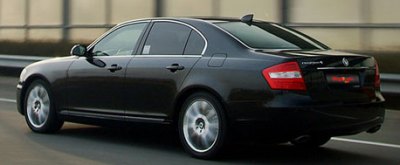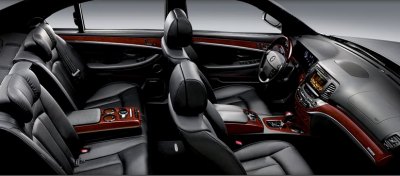Ssangyong Chairman W
Debut: 2008 |
||||||||||
Ssangyong is a very small company compared with Hyundai. It could play the role David against Goliath not because of its own strength, but with the invisible arm of Lord Mercedes. The old Chairman was derived from last generation Mercedes mechanicals and developed with the help of Mercedes engineers. Hyundai Equus also got foreign technology transfer, but that came from Mitsubishi. It's no brainer who would beat another.
When we talk about W220 platform, we also mean its associated technology, such as Airmatic suspension, adaptive damping, 4matic 4WD system, radar cruise control... even the latest 7G-Tronic transmission is included in the supply list ! No wonder Ssangyong claims the new Chairman is a world-class luxury car, one that could compare with Mercedes S-class, BMW 7-series and Audi A8. Subjectively, however, this car doesn't feel like in the same league as its German rivals. Its styling is conservative, outdated and lack of originality – it looks as if a BMW smashed into a Mercedes-Benz from the back, doesn't it ? The car actually looks more like a Chinese product. Ssangyong was briefly owned by China's Shanghai Automotive (SAIC) from 2004 to early 2009, but I think that is not the reason. Development of Chairman W seemed to have started well before the Chinese got effective control. In fact, SAIC was more interested in Ssangyong's SUV know-how, therefore it was not involved in the luxury car program. It should be Ssangyong's designers to take the responsibility for its poor looks. They have been notorious for odd-looking SUVs, so it's not surprise to see another bad design.
Nevertheless, the cabin does provide a lot of space. Bear in mind that Chairman is slightly larger than the old S-class in all dimensions, no matter length, width, height or wheelbase, so it can easily satisfy the most demanding tycoons. For those demanding true limousine grace and space, a long wheelbase version provides an additional 300 mm length to the cabin. Besides, both versions provide a 624-liter trunk, easily topping the class. Apart from space, Chairman also provides a lot of luxury features, such as memory ventilated (heated and cooled) seats, slide and tilt rear seats, power doors, power trunk lid, 8-inch touch screen, armrest-mounted entertainment control system for both rows, Harman/Kardon 7.1 surround sound system (same as Mercedes S-class), an i-Drive like control system, drink cooler/warmer, speech command recognition… By the way, the seat adjustment control seems taken straight from Mercedes. Safety equipment includes the usual traction control, stability control, brake force distribution, tire pressure monitor, radar cruise control and 10 air bags. However, the lack of night vision infrared camera, drowsy detection and Pre-Safe system separates it from the current S-class. After, the German has to reserve the most sophisticated technology for themselves.
For the same reason, Chairman W is powered by older generations of Mercedes engines. Most of the sales are expected to go to the cheaper 3.2-liter (220hp) and 3.6-liter (250hp) straight-six engines. The Mercedes 3.2-liter straight-six was transferred to Ssangyong many years ago, initially powered its SUVs, then also the original Chairman. Later on, it was derived into 3.6-liter version. I still have fond memory of the Mercedes straight-six for its smoothness and eagerness, but compared with its latest V6, it is neither as quiet nor as frugal. Moreover, even in the largest form it is not torquey enough to pull the 2-ton Chairman with the enthusiasm we expected. This mean the 7-speed automatic gearbox works busier than we would like. Previously, Chairman was never offered with V8 engines. As the new Hyundai Equus was set to get its in-house-developed Tau V8, Ssangyong had to respond with the purchase of the late Mercedes M113 5.0-liter V8. You might remember that engine had a special lightweight architecture with SOHC per bank, 3 valves and two spark plugs per cylinder. Its intake variable valve timing, variable intake manifolds and fuel-saving cylinder cut-off technology still sounds modern today. In the Chairman W, its power output is unchanged at 306 hp, though maximum torque has been reduced slightly to 326 pound-foot. The extra punch and smoothness should lift the image of Chairman W a lot. However, I won't say the V8 is the pick of the range. Firstly, it costs as much as 50 percent more than the 3.6-liter car, which is unreasonable. Secondly, it is still not quick enough. It would be okay if it matched the old S-class' 6.2 seconds 0-60 mph acceleration, but hampered by an additional 160 kg of weight, the Chairman takes 6.6 seconds. How can it fight against the top Equus, which offers another 100hp from its 5.0-liter Tau V8 ? To do that, Ssangyong would need the latest Mercedes M273 V8 rather than the old M113.
Nevertheless, Mercedes and Lexus do the comfort job better. Yes, in Korea they ask for twice the money of Ssangyong, but they provide quality, technology and design unmatchable by the Korean car. Despite of its new name, Chairman W is not world-class yet. |
||||||||||
| The above report was last updated on 18 Feb 2010. All Rights Reserved. |
| Specifications | ||||||||||||||||||||||||||||||||||||||||||||||||||||||||||||||||||||||||||||||||||||||||
|
||||||||||||||||||||||||||||||||||||||||||||||||||||||||||||||||||||||||||||||||||||||||
| Performance tested by: - |
Copyright©
1997-2010
by Mark Wan @ AutoZine




